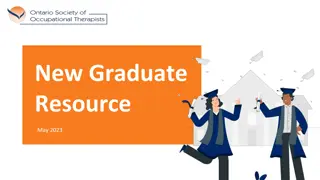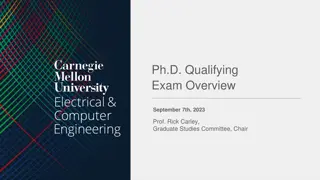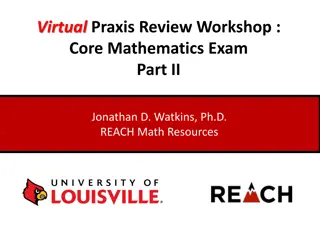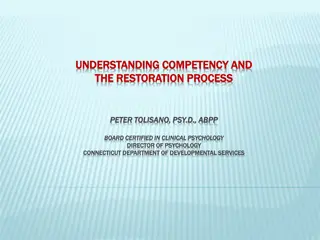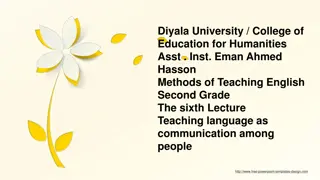Competency-Based Exam Overview
Assistance in understanding competency-based exams for Speech-Language Pathology program entry. Details the National Competency Profile, CETP Exam Blueprint, and strategies for success. Explore roles and responsibilities in the profession
Download Presentation

Please find below an Image/Link to download the presentation.
The content on the website is provided AS IS for your information and personal use only. It may not be sold, licensed, or shared on other websites without obtaining consent from the author.If you encounter any issues during the download, it is possible that the publisher has removed the file from their server.
You are allowed to download the files provided on this website for personal or commercial use, subject to the condition that they are used lawfully. All files are the property of their respective owners.
The content on the website is provided AS IS for your information and personal use only. It may not be sold, licensed, or shared on other websites without obtaining consent from the author.
E N D
Presentation Transcript
LYN TURKSTRA, PHD, REG-CASLPO ASSISTANT DEAN, SPEECH-LANGUAGE PATHOLOGY PROGRAM PROFESSOR, SCHOOL OF REHABILITATION SCIENCE, MCMASTER UNIVERSITY & CHRISTIANE M NARD, MANAGER OF EXAMS, SAC-OAC
WEBCAST AGENDA Definition of a competency-based exam Overview of the National Competency Profile Understanding the CETP Exam Blueprint Strategies and tips for success on a multiple-choice exam Sample questions
PURPOSE OF A COMPETENCY-BASED EXAM To provide a consistent and fair assessment of competencies required for entry into the profession Exam questions are Developed by subject matter experts from the perspective of applying your knowledge, skills, critical thinking and judgement Categorized according to the competencies, or learning outcomes in the National Competency Profile Designed to meet the criteria of the Exam Blueprint
NATIONAL COMPETENCY PROFILE Provides information about the minimum abilities required of an Audiologist or a Speech-Language Pathologist entering practice in a Canadian regulated jurisdiction. Currently available on CETP Exam Web site at https://www.sac-oac.ca/preparing-exam
NATIONAL COMPETENCY PROFILE Paints a picture of how you should practice and what you must be able to do upon entry into the profession Specifies knowledge, skills, critical thinking and judgement that are required to achieve entry-to-practice competencies for safe and effective practice, and are acquired throughout the education program
NATIONAL COMPETENCY PROFILE Describes competencies in seven roles: 1. Knowledge Expert and Clinical Expert 2. Communicator 3. Collaborator 4. Advocate 5. Scholar 6. Manager 7. Professional
1.1 ROLE OF KNOWLEDGE EXPERT 1.2 ROLE OF CLINICAL EXPERT These roles are central to the function of AUDs and S-LPs AUDs apply their knowledge of auditory and vestibular development and disorders S-LPs apply their knowledge of the development and disorders of communications, as well as feeding and swallowing Applied to assessment and intervention, to provide professional, client-centred care to individuals across the lifespan
2. ROLE OF COMMUNICATOR Facilitate the therapeutic relationship and exchanges that occur before, during, and after each encounter. Essential for establishing rapport and trust, sharing information, developing a mutual understanding, and facilitating a shared plan of client-centered care.
3. ROLE OF COLLABORATOR Seek out and develop opportunities to work effectively with other professionals; the client and their family, caregiver, and significant others; and/or the community to achieve optimal client-centred care as well as continuity of care when clients change providers and/or caregivers.
4. ROLE OF ADVOCATE Use their expertise to advance the health and well-being of clients by assisting them to navigate the healthcare or educational system and access support and resources in a timely manner.
5. ROLE OF SCHOLAR Demonstrate a lifelong commitment to professional learning and self-reflection, as well as to the creation, dissemination, application, and translation of current evidence-informed knowledge related to their profession.
6. ROLE OF MANAGER Use their expertise in decisions relating to the service provided to clients in the healthcare or educational system. The decision process may involve co-workers, resources, and organizational tasks.
7. ROLE OF PROFESSIONAL Professionals are guided by a code of ethics, professional standards, regulatory requirements, and a commitment to clinical competence in the service they provide to their clients.
THE EXAM BLUEPRINT The CETP Exam Blueprint is the matrix of the type of exam questions represented in each exam across the competency areas and the percentage of questions from each competency. The CETP Exam Blueprint serves as a guide for the development of exam questions and the construction of an exam. Having an exam blueprint improves consistency across each exam version and ensures the validity and reliability of each exam version.
EXAM BLUEPRINT OVERVIEW 170 MULTIPLE-CHOICE QUESTIONS 20 to 30% - Role of Knowledge Expert Competency 1.1 35 to 45% - Role of Clinical Expert Competency 1.2 5 to 15% - Role of Communicator Competency 2 2 to 7% - Role of Collaborator Competency 3 3 to 7% - Role of Advocate Competency 4 0% - Role of Scholar Competency 5 3 to 7% - Role of Manager Competency 6 5 to 15% - Role of Professional Competency 7
EXAM BLUEPRINT - OVERVIEW Each exam must meet structural requirements: Format and length: 170 multiple-choice questions; 3 hours, 45 minutes Item presentation: mixture of stand-alone and case-based questions Cognitive level: knowledge/comprehension, application, and critical thinking
EXAM BLUEPRINT - OVERVIEW Each exam must include contextual variables: Questions must reflect a ranges of client variables such as race, ethnicity, sex, gender, age, and living situation Questions must reflect a variety of environmental factors, such as location or type of service, family support, and barriers to participation Questions must measure awareness of, sensitivity to, and respect for diversity, without introducing stereotypes
STRATEGIESAND TIPS FOR SUCCESS 1. Take the time to read the question and answer options carefully 2. Once you understand the question, think about what the right answer should contain 3. Look for common types of wrong answers (e.g., answers that are true but not relevant to the question)
STRATEGIESAND TIPS FOR SUCCESS 4. Eliminate answer options in two steps first, eliminate wrong answers, and then reread the question and remind yourself what you are looking for in a correct answer 5. Do not obsess over your choices if you are down to a couple of options, you have 50% chance of choosing the right answer
STRATEGIESAND TIPS FOR SUCCESS 6. Manage your time calculate the time available - 3 h 45 mins = 225 mins, therefore you have 1 min, 30 sec per question 7. Answer every question If you only have a few minutes left in exam, take a guess there is a 25% chance you will get it right!
What should be the first priority in improving functional communication for a six-year-old child with severe childhood apraxia of speech? a) Sound production in connected speech b) Imitation of consonants in isolation c) Building an intelligible core vocabulary d) Drills to improve auditory discrimination COMPETENCY: 1.2.1
When writing an assessment report the speech-language pathologist may omit: a) test scores obtained from other professionals. b) social and environmental case history information. c) subjective observations regarding the client s behaviour. d) statements regarding the client s motivation. COMPETENCY: 2.b
Mary is a 4-year-old girl with Cerebral Palsy. She is receiving occupational, physical and speech-language pathology therapy services. She is being integrated into a community day care. The S-LP will coordinate the follow- up concerning Mary s augmentative communication system, seating, and activities to increase her motor coordination. What service delivery model is being used? a) Unidisciplinary b) Multidisciplinary COMPETENCY: 3.a c) Interdisciplinary d) Transdisciplinary
Which statement about a patients prognosis is consistent with a professional Code of Ethics? a) By the time your child starts school he will have improved b) At this time we can predict c) All children with this disorder have improved d) This therapy program will improve your child s COMPETENCY: 7.b
QUESTIONS? Contact CETP Exam Manager cetpexams@sac-oac.ca This Photo by Unknown Author is licensed under CC BY



